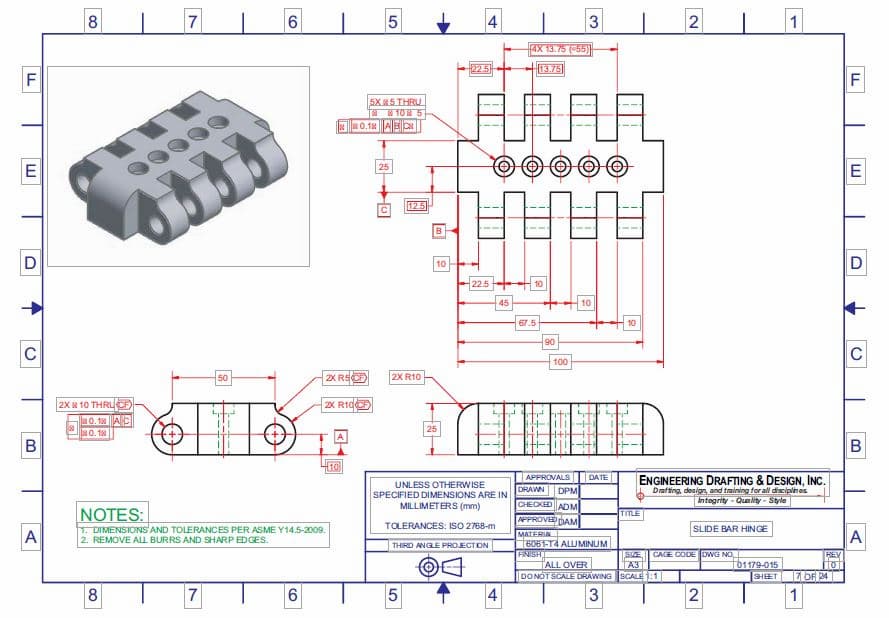COMPUTER-AIDED DESIGN AND DRAFTING (CADD)

CADD offers solutions to most engineering drawing and design problems, and it allows for increasingly complex projects. Several industries and most disciplines related to engineering and architecture use CADD. Most engineering firms and educational institutions that previously used manual drafting practices have evolved to CADD. Professionals have come to rely on the power and convenience of CADD in all aspects of design and drafting. CADD systems include tools to accomplish any drawing and design requirement, such as preparing the 3-D model of a home shown in Figure.
THE CADD WORKSTATION

The CADD workstation consists of a variety of computer hardware. Hardware includes the physical components of a computer system, such as the computer, monitor, keyboard, mouse, and printer. The figure shows a modern CADD work-station. A CADD workstation relies on a computer for data processing, calculations, and communication with peripheral equipment. A peripheral is an external computer hardware device that uses the computer to perform functions that the computer cannot handle.
Peripherals provide input, output, and storage functions and services. Input means to put information into the computer that the computer acts on in some way. Input comes from devices such as the keyboard, a mouse or similar input device, or a digitizer. Output refers to information that the computer sends to a receiving device such as a monitor, a plotter, or a printer. Storage refers to disks and drives that allow the operator to store programs, files, symbols, and data.
CADD SOFTWARE PRODUCTS
The modern CADD workstation is powerful, inexpensive, and supports sophisticated CADD software. Many CADD software manufacturers exist, and numerous products are available to meet industry needs. Some CADD software is general purpose and can apply to any discipline. For example, Autodesk, Inc. produces AutoCAD for 2-D and 3-D design and drafting.
Other products focus on a specific CADD technology, industry, or discipline, such as drawings or models of mechanical parts and assemblies or those for architectural, civil, or structural engineering projects.
For example, Dassault Systèmes SolidWorks Corp. offers SolidWorks for 3-D solid modeling and 2-D drafting that is common in the manufacturing industry. Software specifically designed for CADD in the manufacturing industry is sometimes referred to as mechanical computer-aided design (MCAD) software. Some CADD programs support expanded, third-party, or add-on utilities intended to increase system usefulness for specifi c applications.
The CADD software industry changes constantly. Software manufacturers frequently update existing products or combine, change program names, or eliminate programs to adapt to the rapidly evolving CADD market. Software updates typically include additional and refined tools, increased software stability, and graphical user interface (GUI) enhancements.
Computer Aided Design and Drafting
The interface describes the items that allow you to input data to and receive outputs from a computer system. The GUI provides the on-screen features that allow you to interact with a software program. New products regularly emerge to respond to innovative technology and project requirements. Larger software manufacturers, such as Autodesk Inc., Dassault Systèmes, Parametric Technology Corporation, and Siemens PLM Solutions hold the greatest number of CADD users, and they traditionally have the ability to expand their products and acquire smaller software companies or existing software.
Some software manufacturers offer products intended to support various aspects of product development. For example, some software companies combine CADD and CAM tools for design, drafting, and manufacturing. A few software companies offer specific applications or software packages to help manage all aspects of a project, known as product life cycle management (PLM). PLM systems include tools for CADD, product data management (PDM) to organize and monitor project data, computer-aided engineering (CAE) for simulation and analysis, CAM, and presentation.
Alibre, Inc.
Alibre provides software generally for CADD in the manufacturing industry. Alibre Design is a 3-D solid modeling and 2-D drafting program. The Professional version of Alibre Design includes tools for sheet metal design and rendering. The Expert version of Alibre Design provides additional functions such as simulation and FEA, PDM, CAM, and extended translation tools. Translation occurs when converting data from the fi le system of one CADD system to another, and it is often necessary when sharing CADD data with others, such as consultants, manufacturers, and vendors. Most CADD soft-ware includes tools for some level of fi le translation. Separate translation software is available when necessary. Alibre also offers Alibre Personal Edition, which is a 3-D modeling and 2-D drawing software marketed to hobbyists.
Ashlar-Vellum
Ashlar-Vellum offers basic 2-D and 3-D CADD software. Graphite provides 2-D and 3-D wireframe drawing and modeling capabilities. Argon is a basic 3-D model-ing software for conceptual design, visualization, and translation. Xenon and Cobalt, which include additional functions, are 3-D modeling programs with 2-D drafting capabilities.
Autodesk, Inc.
Autodesk offers a wide variety of soft-ware. AutoCAD is general-purpose 2-D and 3-D CADD software and is the core Autodesk product. Autodesk provides variations of AutoCAD for unique markets, such as Auto-CAD LT for 2-D drafting, AutoCAD Electrical for electrical control system design, and AutoCAD Civil 3-D for civil engineering project design. Additional Autodesk products focus on specifi c CADD technology and industries, such as manufacturing, architecture, construction, infrastructure, media, and entertainment.
Autodesk® Inventor® is a 3-D solid modeling and 2-D drafting program generally for CADD in the manufacturing industry. Autodesk Inventor provides a comprehensive and flexible set of software for 3-D mechanical design, simulation, design visualization and communication, tooling creation, and 2-D documentation. Autodesk offers Autodesk Inventor Suites that combine Autodesk Inventor, AutoCAD Mechanical, and tools for specifi c applications, such as mold, tube and pipe, and cable and harness design. Some Autodesk Inventor Suites also include simulation and analysis functions. Autodesk Revit is a 3-D building design program with 2-D drafting and documentation capabilities. Versions of Autodesk Revit focus on design for architecture, mechanical, electrical, and plumbing (MEP), or building information modeling (BIM) for structural engineering. Autodesk manufactures numerous other software products, including Autodesk Algor Simulation for solid model simulation and FEA, Autodesk Vault for PDM, 3ds Max for 3-D modeling, animation, and rendering, and software to support the sustainable and environmentally friendly design and development.
Bentley Systems, Inc.
Bentley Systems focuses on software for engineering and construction infrastructure design, documentation, and operation. Infrastructure is the structures, facilities, and services required for an economy to function, such as buildings, roads and bridges, water supply and sewer systems, and power-supply and telecommunication systems. Micro Station is a general-purpose 2-D and 3-D CADD soft-ware and is the primary Bentley Systems product. Micro-Station also acts as a platform for other Bentley Systems software. For example, GEOPACK Civil Engineering Suite includes tools for civil engineering and transportation project design. Micro Station PowerDraft is a version of MicroStation mainly for 2-D drafting. Bentley Systems manufactures other software, including Project Wise for PDM, and ProConcrete for 3-D modeling, detailing, and scheduling of reinforced concrete structures.
Dassault Systèmes
Dassault Systèmes brands offer several soft-ware products generally focused on CAD and related technology for the manufacturing industry. CATIA is a project development system and is the main Dassault Systèmes brand product. CATIA provides tools for 3-D solid modeling and 2-D drafting and tools for specifi c applications, such as mold, tube and pipe, cable and harness, and electronic design. CATIA also offers simulation and analysis, CAM, and PDM functions. The additional Dassault Systèmes brand software focuses on specifi c aspects of PLM.
SolidWorks is a 3-D solid modeling and 2-D drafting program and is the core Dassault Systèmes SolidWorks (www. solidworks.com) brand product. Dassault Systèmes SolidWorks offers a standard version of SolidWorks and suites that incorporate SolidWorks with simulation, analysis, and PDM tools. SolidWorks Simulation includes tools for solid model simulation and FEA. SolidWorks Flow provides fluid-flow simulation and thermal analysis. Dassault Systèmes SolidWorks also manufactures software to support the sustainable and environmentally friendly design and manufacturing.
Google Inc.
Google SketchUp is a software intended to have an easy to use interface for creating, sharing, and presenting 3-D models. Common applications for Google SketchUp include sketching and modeling for visualization during the conceptual design phase of a project and creating presentation drawings that look hand-sketched or photorealistic. Google SketchUp also links to Google Earth for sketching relative to a physical location, such as modeling a building on an actual lot.
GRAPHISOFT
GRAPHISOFT focuses on software for the architecture, engineering, and construction (AEC) industry. ArchiCAD is a 3-D building design program with 2-D drafting and documentation capabilities; it is the main GRAPHISOFT product. MEP Modeler adds 3-D and 2-D MEP functions to ArchiCAD. Virtual Building is a 3-D digital database that tracks all elements that make up a building, allowing the designer to use items such as surface area and volume, thermal properties, room descriptions, costs, product information, and window, door, and finish schedules. Virtual refers to something that appears to have the properties of a real or actual object or experience. GRAPHISOFT also manufactures photo-realistic rendering software and software to support sustainable and environmentally friendly architectural design and construction.
IMSI/Design, LLC
IMSI/Design offers basic CADD software for general-purpose and project-specific applications. TurboCAD is the core IMSI/Design product. IMSI/Design provides variations of TurboCAD for unique markets, such as TurboCAD Designer for 2-D drafting, TurboCAD Deluxe for 2-D drafting and 3-D modeling, and TurboCAD Pro with additional 2-D and 3-D CADD functions. Additional IMSI/Design products focus on specifi c CADD technology and industries, such as Home & Landscape and Instant Architect for basic 2-D and 3-D home design.
Intergraph
Intergraph manufactures software for specific industries and projects, including the design, construction, and operation of plants, ships, offshore facilities, and transportation and utility systems. For example, SmartMarine 3-D is specialized software for 3-D model-ing, design, and documentation of marine structures, such as commercial ships. Intergraph also offers SmartSketch for 2-D drafting.
Iron CAD
IronCAD provides software generally for CADD in the manufacturing industry. IRONCAD is a 3-D solid modeling and 2-D drafting program with PDM functions. A third-party application offers simulation and FEA tools compatible with IRONCAD. INOVATE is a version of IRONCAD with fewer 3-D modeling functions and no 2-D drafting capabilities.
Kubotek Corporation
Kubotek manufactures CADD and CAM software. KeyCreator is a 3-D solid modeling and 2-D drafting program generally for CADD in the manufacturing industry; it is the chief Kubotek product. Kubotek Validation Tool confirms design accuracy during or after a specifi c activity, such as a design revision or data translation. Kubotek also manufactures KeyMachinest for CAM and maintains CADKEY for 3-D wireframe modeling.
Parametric Technology Corporation
Parametric Technology Corporation, or PTC, offers several software products generally focused on CADD in the manufacturing industry. Pro/ENGINEER is a 3-D solid modeling and 2-D drafting program and is the core PTC software. PTC provides various additions to the Pro/ENGINEER platform, including tools for CAE, CAM, and PDM: for example, Pro/ENGINEER Mechanica for simulation and FEA, Pro/ENGINEER Piping and Cabling Extension for pipe and cable design, and Pro/ENGINEER Reverse Engineering for automating reverse engineering. Reverse engineering is the process of converting an existing physical product into drawings or digital models, and it involves discovering the technological principles of a device, object, or system by analyzing its structure, function, and operation.
PTC manufactures other software, including Windchill for PDM, CoCreate for CAD, CAE, and PDM, and MathCAD for engineering calculations.
Siemens Corporation
Siemens Corporation offers a wide variety of products and services. The Siemens PLM Solutions (www.plm.automation. siemens.com) brand manufactures PLM software. NX ad-dresses each area of product development, and it is the primary Siemens PLM Solutions software. NX provides tools for 3-D solid modeling, 2-D drafting, and specific applications such as tool and fixture, routed system, and sheet metal product design. NX also offers simulation, FEA, CAM, and PDM functions. In addition to NX, Siemens PLM Solutions produces SolidEdge for 3-D solid modeling and 2-D drafting, generally for CADD in the manufacturing industry. The additional Siemens PLM Solutions brand software focuses on specifi c aspects of PLM.
Australian Design & Drafting Services provide excellent service for CAD Design and Drafting. Contact Us for more info
What is computer-aided design and drafting?
Computer-aided design and drafting (CADD), also known as computer-aided design (CAD), refers to the use of computer software to assist in the creation, modification, analysis, or optimization of designs for a wide range of applications.
CAD software allows designers, engineers, architects, and other professionals to create precise 2D drawings or 3D models of objects, buildings, mechanical parts, electrical circuits, and more. These digital representations can be manipulated, viewed from different angles, and tested for various factors such as stress, fluid dynamics, or thermal properties.
CAD software often includes tools for drafting, modeling, rendering, and simulation, enabling users to produce accurate and detailed designs efficiently. It has revolutionized the design process in many industries, leading to faster prototyping, reduced errors, and improved collaboration among team members.
What is computer aided drafting CAD used for?
Computer-aided drafting (CAD) is used in a variety of industries for designing and drafting technical drawings and plans with the assistance of computer software. Here are some common applications:
Architecture and Construction: CAD is extensively used by architects and engineers to create detailed plans for buildings, bridges, roads, and other structures. It allows for precise measurements, accurate representations of designs, and the ability to easily make changes.
Mechanical Engineering: CAD software is indispensable in the field of mechanical engineering for designing machine parts, tools, and mechanical systems. It enables engineers to create 2D and 3D models, perform simulations, and analyze the performance of components.
Product Design and Manufacturing: CAD is crucial in the product design process, allowing designers to create digital prototypes of products before they are manufactured. It facilitates the visualization of designs, helps in testing for functionality and ergonomics, and streamlines the manufacturing process.
Electrical and Electronic Systems: CAD is used for designing circuit boards, electrical systems, and electronic components. It enables engineers to create schematics, layout PCBs (Printed Circuit Boards), and simulate electrical circuits to ensure optimal performance.
Interior Design: CAD software is utilized by interior designers to create floor plans, furniture layouts, and interior designs for residential and commercial spaces. It helps in visualizing designs, experimenting with different layouts, and presenting ideas to clients.
Urban Planning and GIS: CAD is employed in urban planning for creating detailed maps, land-use plans, and infrastructure designs. It plays a crucial role in visualizing proposed developments, analyzing spatial data, and making informed decisions about city planning.
Aerospace and Automotive Industries: CAD software is used extensively in these industries for designing aircraft, spacecraft, automobiles, and other vehicles. It aids in creating complex assemblies, performing aerodynamic simulations, and optimizing designs for performance and safety.
